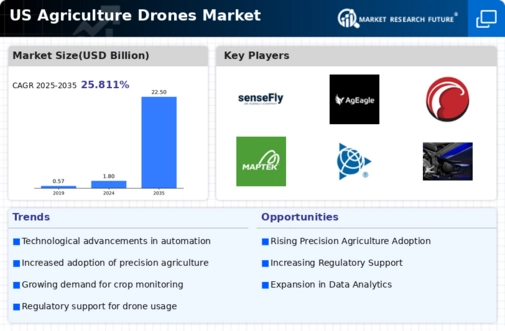The US Agriculture Drones Market has witnessed significant growth driven by the increasing need for precision agriculture and advancements in drone technology. As farmers look for innovative solutions to enhance crop yields, reduce costs, and improve operational efficiency, agricultural drones have emerged as valuable tools in modern farming practices. The competitive landscape is marked by various companies offering a range of drone solutions, each contributing unique strengths and technological advancements tailored to meet the specific needs of the agriculture sector.
As more stakeholders recognize the potential benefits of integrating drones into their agricultural practices, the market dynamics continue to evolve, with companies striving to establish strong market positions through strategic initiatives, product innovations, and customer-centric approaches.senseFly stands out in the US Agriculture Drones Market due to its emphasis on delivering high-quality solutions that encourage efficiency and accuracy in agricultural operations.
The company offers a robust lineup of fixed-wing drones specifically designed for agricultural mapping and monitoring applications, providing farmers with invaluable insights into their crops and land. senseFly’s strengths lie in its established reputation for producing reliable and easy-to-use UAVs along with its commitment to customer education and support. Their technology enables farmers to gather data quickly and effectively, improving decision-making processes and operational outcomes.
By continuously investing in R&D and enhancing product features, senseFly maintains a competitive edge in the rapidly evolving agriculture drone segment in the US market.AgEagle Aerial Systems plays a significant role in the US Agriculture Drones Market with a strong focus on developing cost-effective drone solutions aimed at improving agricultural productivity. The company has developed key products and services that support precision agriculture through high-resolution aerial imagery, mapping, and data analytics. AgEagle Aerial Systems has established its market presence through strategic partnerships and acquisitions that enhance its technological capabilities and expand its product offerings.
One of the company’s strengths is its ability to integrate software and drone technology, which allows for seamless data management and actionable insights for farmers. Furthermore, AgEagle’s ongoing efforts in mergers and acquisitions help to reinforce its position in the market and expand its capabilities, enabling it to cater effectively to the diverse needs of the US agricultural community. The company continues to innovate while remaining focused on enhancing its product lines to support the evolving demands of precision farming.






















Leave a Comment